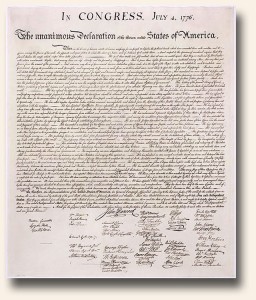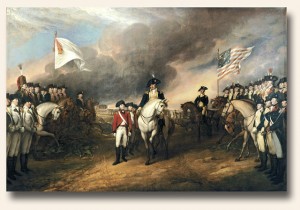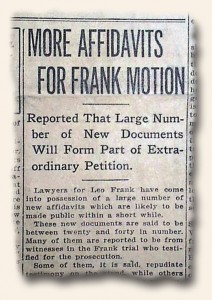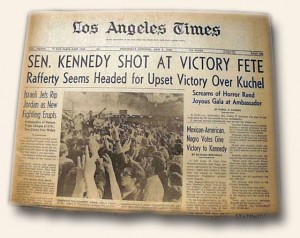Living in the moment…
April 28, 2014 by TimHughes · Leave a Comment
 One of the joys of reading newspapers of a bygone era is the opportunity to put yourself in a very special moment in history. One fine example is the report in the August 22, 1776 issue of “The Continental Journal” from Boston, which notes that: “…immediately after divine worship, the Declaration of Independence was read by Col. St. Clair, and having said, ‘God save the free independent States of America!’ the army manifested their joy with three cheers. It was remarkably pleasing to see the spirit of the soldiers so raised after all their calamities, the language of every man’s countenance was, now we are a people! we have a name among the states of this world.“
One of the joys of reading newspapers of a bygone era is the opportunity to put yourself in a very special moment in history. One fine example is the report in the August 22, 1776 issue of “The Continental Journal” from Boston, which notes that: “…immediately after divine worship, the Declaration of Independence was read by Col. St. Clair, and having said, ‘God save the free independent States of America!’ the army manifested their joy with three cheers. It was remarkably pleasing to see the spirit of the soldiers so raised after all their calamities, the language of every man’s countenance was, now we are a people! we have a name among the states of this world.“
Such editorial commentary brings the excitement of the period to life. This is truly the way to enjoy history–what a wonderful hobby!
Not found in history books…
April 25, 2014 by TimHughes · Leave a Comment
It is often the commentary on events in history, as found only in newspapers of the day, which provide a window onto the events not to be found in history books. Such is joy of browsing through old newspapers.
 A great example is an eye-witness account of the surrender of Cornwallis at Yorktown as told in the November 13, 1781 issue of the “Pennsylvania Packet” of Philadelphia. found very inconspicuously on page 3 is: “Permit me to congratulate you on the success of the allied arms, the fall of the boast of Britain! the flower of its army…The allied army was drawn up in two straight lines, facing each other, leaving a space for the British column to pass. The commander in chief with his suite on the right of the American line; the count de Rochambeau opposite, on the left of the French. Lord Cornwallis pleading indisposition, the British were led by general O’Hara, conducted by general Lincoln, their colours cased, and they not allowed to beat a French or American march. The British officers in general behaved like boys who had been whipped at school; some bit their lips, some pouted, others cried…”. Only in a newspaper would this commentary be found. What a wonderful hobby!
A great example is an eye-witness account of the surrender of Cornwallis at Yorktown as told in the November 13, 1781 issue of the “Pennsylvania Packet” of Philadelphia. found very inconspicuously on page 3 is: “Permit me to congratulate you on the success of the allied arms, the fall of the boast of Britain! the flower of its army…The allied army was drawn up in two straight lines, facing each other, leaving a space for the British column to pass. The commander in chief with his suite on the right of the American line; the count de Rochambeau opposite, on the left of the French. Lord Cornwallis pleading indisposition, the British were led by general O’Hara, conducted by general Lincoln, their colours cased, and they not allowed to beat a French or American march. The British officers in general behaved like boys who had been whipped at school; some bit their lips, some pouted, others cried…”. Only in a newspaper would this commentary be found. What a wonderful hobby!
The Traveler… premature death… Tecumseh… substituting…
April 21, 2014 by The Traveler · Leave a Comment
 Today I traveled to Boston, Massachusetts by the way of The Yankee dated April 22, 1814. There I found an article on an embargo of vessels in the American harbors. This also included “…[Here the Editor gives a report of the capture of the President by the Majestic; and, says the article, Commodore Rodgers was killed.]…” Considering he died on August 1, 1838, I would say that this was a premature reporting of his death!
Today I traveled to Boston, Massachusetts by the way of The Yankee dated April 22, 1814. There I found an article on an embargo of vessels in the American harbors. This also included “…[Here the Editor gives a report of the capture of the President by the Majestic; and, says the article, Commodore Rodgers was killed.]…” Considering he died on August 1, 1838, I would say that this was a premature reporting of his death!
The last page of this issue contains a great “Biographical – Character of Tecumseh.” “The celebrated aboriginal warrior, Tecumseh was in the 44th year of his age, when he fell at the battle of the Thames. He was of the Shawanoe tribe, five feet ten inches, high, well formed for activity and the endurance of fatigue, which he was capable of sustaining in a very extraordinary degree…”
A great story from Georgia. A “youthful citizen” had volunteered his services to the military. Approaching battle, he was afraid that he may not survive so he found himself a substitute and returned home to his “heart’s delight.” She had already heard of what he had done and was not pleased of his patriotic indignation. When he had informed her of his intentions of their engagement, she replied “I must refuse to fulfill my engagement, until you employ a substitute.”
~The Traveler
#18 – America’s first newspaper… Check your attics. (*revisited)
April 18, 2014 by GuyHeilenman · Leave a Comment
The very first newspaper printed in the American colonies was published in Boston in 1690 and titled “Publick Occurrences Both Foreign and Domestick”. It was a little paper with three pages of text. The fourth page was left blank for others to write handwritten pieces of news before being passed on to others. It was published by Benjamin Harris who had experience in publishing another newspaper in London several years prior to his arrival in the colonies, titled “Domestick Intelligence, Or News Both from City & Country”.
His Boston effort focused on local news but it also included gossip and unflattering reports. One account notes it contained: “…affections of a very high nature: As also sundry doubtful and uncertain Reports…”. The mixture of doubtful and uncertain reports, as well as a ban on printing without a license which Harris did not have, caused his first issue to also be his last. Reports note that the royal governor had the printing press destroyed and all known issues of that one date of September 25, 1690 confiscated.
To this day only one genuine issue of the newspaper is known to exist, and unfortunately it’s not in the United States: it is in the Public Records office in London. Some years ago it was loaned to The Newseum in Washington, D.C. (then located across the Potomac in Virginia) for a period of time, but I believe it has been returned to London.
The intriguing part of this story is that “all known issues were confiscated and destroyed”. But exactly when did this happen? Was it done several hours since it was printed, or a few days later? It was intended to be a monthly publication. Certainly the possibility exists that a few issues were not found & confiscated, and with the owners knowing of the search they may have purposely hidden them away.
Could an issue or two still exist in a Boston attic somewhere? Is there a private library where an issue was hidden among the pages of a book in hopes of not being confiscated? Could a renovation project to a Boston area home reveal an issue tucked within its walls over 300 years ago? It is fascinating to think that some examples could be found so long after being published. But to this date none have surfaced.
Speculation runs wild as to the value of an issue should it surface. It’s America’s very first newspaper, and none exist in America. What sort of price could be set on such an issue? What should be the future home of an issue should it be found?
Feel free to comment!
—————
*The Fall of 2013 marked the 5th anniversary of the History’s Newsstand Blog by Timothy Hughes Rare & Early Newspapers. We are grateful to have the opportunity to contribute to the newspaper collecting community, and appreciate those who have participated through guest posts, comments, and readership. This year (2014) we are revisiting the top 25 posts (measured by activity), with the number 1 post being re-posted during the first week of 2015. Please enjoy. If you would like to contribute a post for consideration of inclusion on the blog, please contact Guy Heilenman at guy@rarenewspapers.com.
An unusual two issue set… a disaster and a massacre…
April 11, 2014 by GuyHeilenman · Leave a Comment
 The Set: FRANK LESLIE’S ILLUSTRATED NEWSPAPERS, New York, both dated May 3, 1873.
The Set: FRANK LESLIE’S ILLUSTRATED NEWSPAPERS, New York, both dated May 3, 1873.
The Intrigue: A two issue set of the same title with the exact same date? Yes. In regards to standard daily newspapers, especially those printed for major city distribution, it was not uncommon for there to be multiple editions of the newspaper printed on the same day – perhaps a morning and evening edition. However, we have yet to discover a weekly illustrated newspaper who printed more than one version of an issue on the same day. It is this lack of discovery to-date which makes this two-issue set rather interesting. Frank Leslie’s Illustrated apparently printed two nearly identical but different issues for May 3, 1873… each having a different cover. One might think they accidentally reprinted a cover from a previous week for some of the issues, but we have had the other issues surrounding this date, and none of them have either cover in question. Additionally, while the inner pages are almost all the same, there is also another page (pg 125) which is different. Everything else is identical.
If anyone is aware of the background concerning this set, please share.
Note: Additional (and quite interesting) information concerning both front pages may be found at Colfax Massacre and Richmond Switch Disaster (Rhode Island).
The Traveler… Leo Frank… “Watchful, Waiting”…
April 7, 2014 by The Traveler · Leave a Comment
 Today I traveled through Atlanta, Georgia by the way of The Atlanta Constitution dated April 7, 1914. There I found the defense attorneys for Leo Frank had come into possession of a large number of new affidavits which would be made public shortly. Also coverage of the war in Mexico between Carranza and Pancho Villa. This also has the reporting of the Fall of Torreon with the reporting of the expulsions of the Spaniards.
Today I traveled through Atlanta, Georgia by the way of The Atlanta Constitution dated April 7, 1914. There I found the defense attorneys for Leo Frank had come into possession of a large number of new affidavits which would be made public shortly. Also coverage of the war in Mexico between Carranza and Pancho Villa. This also has the reporting of the Fall of Torreon with the reporting of the expulsions of the Spaniards.
“Watchful, Waiting” policy is how Lloyd Brown was dealing with his 14-year marriage as he was bringing a divorce suit to court. He said shortly into the marriage his wife “began to take a violent dislike to him… She had not only left the house, but had taken all the covers off the bed before so doing. I borrowed some more from a neighbor and, when my wife came back in the morning,…I explained to her that to her that things couldn’t go along that way much longer… I just sat there and said nothing. Well, that made her madder and madder, I just sat still and kept quiet. Finally she hit me over the head with a fire shovel.” She left that night and never returned. Divorce granted.
~The Traveler
Why historic newspapers? Time travel… raw emotion…
April 4, 2014 by GuyHeilenman · Leave a Comment
 I remember the first time I held an authentic Civil War era newspaper and was struck by the concept of holding history in my hands. As I read through the detailed battle reports, raw emotion welled up within me as I pondered the possibility of a loved one’s tears falling upon the very newspaper I was holding – as he/she discovered the name of a close relative… even a spouse listed among those killed in battle. As I continued to peruse the paper, the prevalence of ads, birth and wedding announcements, local news reports, etc. communicated a truth that hit me like a ton of bricks: Despite the carnage of war, and the tears of many who had just learned of the loss of someone they loved, life continued to move forward. Anyone who has lost a dear friend or family member knows the emotion: “Hey world – What are you doing? STOP! Don’t you know what’s just happened?” But the train of time rushes forward – ignoring our desperate cry for just a few more minutes…
I remember the first time I held an authentic Civil War era newspaper and was struck by the concept of holding history in my hands. As I read through the detailed battle reports, raw emotion welled up within me as I pondered the possibility of a loved one’s tears falling upon the very newspaper I was holding – as he/she discovered the name of a close relative… even a spouse listed among those killed in battle. As I continued to peruse the paper, the prevalence of ads, birth and wedding announcements, local news reports, etc. communicated a truth that hit me like a ton of bricks: Despite the carnage of war, and the tears of many who had just learned of the loss of someone they loved, life continued to move forward. Anyone who has lost a dear friend or family member knows the emotion: “Hey world – What are you doing? STOP! Don’t you know what’s just happened?” But the train of time rushes forward – ignoring our desperate cry for just a few more minutes…
At this point I took a breath – carefully closed the newspaper, and returned to the present – convinced I had discovered the greatest hobby of them all; one that enables anyone who would dare, to go where Orson Wells, Jack Finney, and others could only dream of going: back in time.
A collector recently sent a related note stating:
Like many people I’m sure, I have over the years fantasized many times about being able to go back in time. I realize now that this hobby has enabled me to get just a glimmer of that feeling inside, as I hold such old papers, reading the words and seeing the engravings and old photos. Touching the history in such a physical, tangible way evokes a feeling as close to time travel as we can probably ever come…and is a unique  experience utterly lacking in the high school history textbooks I originally studied, or merely looking at images on a computer monitor these days. -Actapublicurist
experience utterly lacking in the high school history textbooks I originally studied, or merely looking at images on a computer monitor these days. -Actapublicurist
Yet another, upon discovering the Bobby Kennedy Assassination Report issue shown in the image wrote (in part):
I will never sell this newspaper… I will be 60 in November and lived in Brooklyn when Senator Kennedy was killed. I still shed tears when I think about it all these years later. He left nine children (and a tenth on the way) and a wonderful wife, and we will never know what a difference this magnificent man with a huge heart would have made in the White House. I grieve for him as if he was close friend. I will treasure this newspaper and others in my ample collection of the RFK assassination.
What an incredible hobby!


